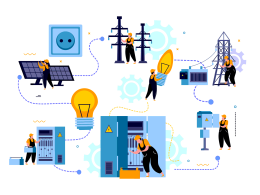In today’s digital age, we have access to an abundance of communication tools at our fingertips. We can send emails, text messages, direct messages on social media platforms and even video chat with people halfway across the world. However, with all these advancements in technology comes a new challenge – how to navigate misunderstandings in virtual communication. In this blog post, we will explore the importance of clarity in digital communication and provide strategies for improving it. So get ready to sharpen your skills and communicate more effectively online!
The Challenge of Clarity in Digital Communication
In today’s world, digital communication is the norm. We rely on emails, texts and instant messages to communicate with our colleagues, friends and family. However, this kind of communication has its challenges. One of the biggest hurdles we face is clarity.
Unlike traditional in-person conversations where tone, body language and context can help us understand what someone means or intends to say; digital communication lacks these cues which can lead to misunderstandings.
Digital communication also poses a challenge when it comes to expressing emotions effectively. For instance, sarcasm or jokes that might come off as funny in person might be taken the wrong way online without proper context or tone.
Furthermore, there are often distractions while communicating digitally like notifications from other apps or devices which can lead to miscommunication if we’re not paying attention fully.
It’s important for us all to recognize these challenges so we can address them head-on by improving our digital communications skills through different strategies such as practicing active listening and being mindful of how we convey ourselves via text-based platforms.
The Different Forms of Digital Communication
In the digital age, there are numerous ways to communicate with others. From sending emails and text messages to using social media platforms, we have more options than ever before. Each form of digital communication has its own strengths and weaknesses, making it important to choose the right one for each situation.
Email is a popular choice for professional communication as it allows for longer messages and attachments. However, it can also be less immediate than other forms of communication like texting or instant messaging.
Texting is a common way that people communicate casually with friends and family. It’s quick and convenient but may not always provide enough context or detail.
Instant messaging on platforms such as WhatsApp or Facebook Messenger combines the convenience of texting with features like read receipts and typing indicators, making conversations feel more real-time.
Video conferencing tools like Zoom have become increasingly popular in recent times due to their ability to connect remote teams face-to-face quickly and easily. They allow participants to see each other’s facial expressions which can help build better connections between team members.
Social media channels like Twitter or LinkedIn offer unique opportunities for individuals and businesses alike to share information publicly with large audiences while still allowing some level of personalization through profiles.
Choosing the right form of digital communication depends on factors such as audience type, message content, urgency level etc., so take time when deciding how best communicate your message!
The Importance of Context in Digital Communication
Effective communication requires more than just clarity of words. The context in which the words are used can also significantly impact their meaning and interpretation. In digital communication, where tone, body language, and facial expressions are absent, context plays an even more crucial role.
Context provides the necessary background information to help us understand what is being communicated accurately. Without it, messages can be misinterpreted or taken out of context leading to misunderstandings or worse yet conflict between parties.
In digital communication, context involves not only understanding who we are communicating with but also how they may perceive our message based on cultural differences and personal experiences. It’s essential to consider this when crafting our messages.
It’s always helpful to provide a brief introduction or explanation before jumping into your main point when communicating digitally. This helps set the stage for proper contextualization of your message.
Always remember that effective communication is a two-way street. Encourage feedback from the person you’re communicating with so that you can adjust your approach accordingly for better clarity and comprehension moving forward.
Strategies for Improving Clarity in Digital Communication
Improving clarity in digital communication can be challenging, especially when there is a lack of face-to-face interaction. Misunderstandings often occur due to the ambiguity of messages sent through text or email. Below are some strategies that can help enhance clarity in virtual communication.
Firstly, it’s essential to understand the importance of being concise and straightforward when communicating digitally. Avoid using complicated vocabulary or lengthy sentences as they may confuse the reader. Instead, use simple words and short sentences to convey your message effectively.
Secondly, it’s crucial to provide context when sending messages. When writing an email or text message, make sure you include important details such as dates, times and locations so that the recipient has a clear understanding of what you’re trying to convey.
Thirdly, try asking questions if something isn’t clear. If you receive a message that seems ambiguous or confusing, don’t hesitate to ask for clarification from the sender instead of making assumptions.
Fourthly, pay attention to tone when communicating digitally. Without facial expressions and body language cues present in face-to-face conversations; it’s easy for recipients to misinterpret your intended tone wrongly.
Proofread before hitting send! Carefully reviewing your written content will help prevent any errors or misunderstandings caused by typos or grammatical mistakes that could affect your overall intention.
In conclusion,
Communicating with others online requires extra attention and effort than traditional methods since we rely on written word rather than verbal cues like inflection and emphasis on specific phrases. By following these tips above mentioned strategies outlined above along with other similar ones not included here will improve how well we communicate virtually while also minimizing misunderstanding between us all as online users who may have never met one another physically yet need efficient reciprocal conversation nonetheless!
Conclusion
In a world where digital communication has become the norm, clarity in our virtual interactions is more important than ever before. Misunderstandings can easily occur when there are no visual or auditory cues to guide our understanding of what someone means.
To navigate these challenges effectively, we need to understand that different forms of digital communication require different approaches. Whether we are sending an email, texting, or using video conferencing software like Zoom or Skype, it’s crucial to pay attention to context and adapt accordingly.
Fortunately, there are strategies we can use to improve clarity in digital communication. These include being concise and clear in our language choices, focusing on active listening techniques such as paraphrasing and asking clarifying questions when needed.
By implementing these strategies consistently over time while also keeping an open mind towards other perspectives and interpretations of what is being said online – we can strengthen the quality of our virtual interactions significantly.
In conclusion- with greater awareness around how we communicate digitally combined with small but meaningful changes implemented into our daily virtual conversations- misinterpretations in messages will drastically decrease leading us down a path towards stronger relationships both personally and professionally!










